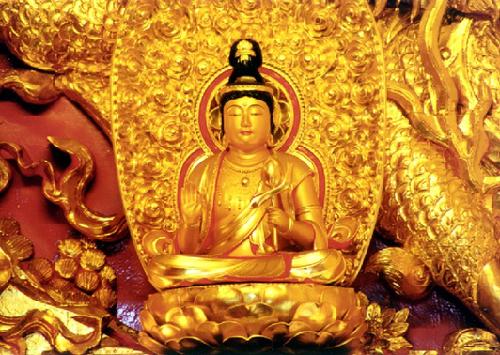Buddhism has been one of the major shaping forces of Chinese civilization. Though not an indigenous religion, Buddhism has the largest number of followers in China, and wields far-reaching influence among its people. During its 2,000-year presence in China it has reached every corner of the country and touched every aspect of Chinese life. Buddist icons can even be found hewn into the country’s mountainsides.

Yet for several decades Buddhism was out of favor. Recent years have seen a strong comeback. The increasing wealth created over the past decades of strong economic growth comes at the cost of crushing pressures and fast tempo of life that has shattered the inner peace of many people. They often turn to religion for spiritual solace and guidance. As part of this trend Buddhist treasures have become new favorites among the country’s ballooning legion of collectors.
Last fall China Guardian Auctions staged a special auction for gold and copper Buddhist figures, during which items worth a total of RMB 48 million were hammered out. The company’s porcelain auction saw fierce competition over a sitting Amitayus Buddha statute dated to the rule of Qing Emperor Qianlong (1711-1799). It finally sold for RMB 10.81 million.
The figurine was made for the royal family and so entailed the highest technical expertise of its period. The Buddha’s skin has a glossy, rosy sheen, and his elaborately outlined attire is painted in brilliant colors. The vase he holds and the podium he sits upon were fired separately from the main body of the artifact, a highly skilled and challenging task in ceramic ware making. The piece is a rare intact specimen that fuses inland China’s advanced porcelain craft with exotic Tibetan Buddhism culture from its frontier regions.
At the Guardian’s gold and copper statues auction the highest offer – RMB 9.89 million – went to a gilded Vajrasattva sculpture from the Xuande period (1426-1435) of the Ming Dynasty. It was formerly owned by a Taiwanese collector. Another Ming Dynasty statue, depicting a cross-legged Manjusri, fetched over RMB 3 million.
The fever for Buddhist artifacts has shown no sign of abating over the past few years. Sales at auctions in China’s mainland have grown at 20 percent annually since 2004, and around 10 auctions are staged exclusively for Buddhist statues every year. Like many other Chinese antiques, these religious treasures were smuggled out of the country during the upheaval caused by the wars that plagued China in the first half of the last century. Items on offer at auctions are mostly from overseas collectors.
Buddhist figures first appeared in China between the first century BCE and the first century CE. During the Southern and Northern Dynasties (420-581) Buddhism underwent a boom, with the technologies used to create religious images rising alongside it, until its cultural and political peak in the Tang Dynasty (618-907). Stone carvings of Buddhist figures can be found all over China, with the best at the Dunhuang, Longmen, Yungang and Maijishan grottoes.
During its long history in China, Buddhism integrated with native culture and customs, and indigenous elements can thus be seen in Chinese Buddhist artworks. These include Guan Yu, a third-century warrior who was later apotheosized as the God of War and is also a feature of some Buddhist creations.
